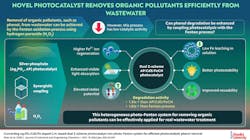A recent study published in the Journal of Industrial and Engineering Chemistry developed a new, highly reusable system for removal phenols from water. The system combines Fenton oxidation with photocatalysis for higher degradation and resource efficiency.
The new photocatalytic system shows promise for practical applications in wastewater purification. In addition, the findings of this study could provide insights on how to design a new generation of catalytic systems for large-scale water treatment.
In 2021 most water bodies in the world are contaminated, and organic pollutants form a major part of this contamination. Organic pollutants can not only endanger aquatic life but can also affect human health. Phenols, in particular, are a robust category of toxic organic pollutants that accumulate over time in soil and groundwater and are not easily biodegradable.
Over the years, scientists have discovered many chemical techniques for removing phenol from water. One of the most energy-efficient and flexible approaches for this is the “Fenton oxidation” process, in which a reaction between hydrogen peroxide (H2O2) and Fe2+ ions yields highly oxidizing hydroxyl ions (.OH) that, in turn, degrade phenols into carbon dioxide and water.
However, despite being highly feasible and repeatable, the Fenton process is very slow, consumes an excessive amount of H2O2 during oxidation, and has lower catalytic activity compared to semiconductor-assisted photocatalysts.
Semiconductor-based photocatalysts, when exposed to light, generate pairs of electrons and “holes” (the absence of electrons in atomic sites). These pairs produce .OH radicals (similar to the Fenton process) along with .O2 radicals, which help with the degradation of phenol. Despite their better catalytic activity, however, photocatalytic reactions are often bottlenecked by weak light activity and inadequate electron-hole separation.
Now, scientists seem to have found the perfect strategy—coupling the Fenton reaction and photocatalysis to extract the best of both worlds. Researchers from India and Saudi Arabia have combined an Ag3PO4/CdS/Fe-g-C3N4 (AP/CdS/FeCN) photocatalyst with H2O2 to develop a heterogenous photo-Fenton system.
In this system, the photocatalyst mimics the natural process of photosynthesis and harvests light to undergo oxidation/reduction reactions.
Prof. Pardeep Singh from Shoolini University, India, who was part of the study, explains, “We opted for a dual Z-scheme approach since it is emerging as an effective way to enhance light absorption ability, photostability and separation of photogenerated electron-hole pair in Ag3PO4 photocatalyst.”
Scientists subjected the fabricated system to phenol removal tests and found that the new coupled system showed higher degradation rates than those from individual approaches. Furthermore, the photo-Fenton system was highly photostable and reusable, maintaining its catalytic activity even after five successive cycles of usage. Scientists attributed the enhancement in phenol degradation rate to the generation of more Fe2+ ions and .OH radicals in the reacting mixture due to the coupling.
“Apart from its practical implications, the novelty of this technique could invoke interest in researchers to explore and discover newer methods for environmental remediation and pave a path towards sustainable development,” comments Associate Professor Pankaj Raizada of Shoolini University, who was also part of the research team.
SOURCE: Shoolini University
Aftab Aslam Parwaz Khan, Pardeep Singh, Pankaj Raizada, Abdullah M Asiri, Converting Ag3PO4/CdS/Fe doped C3N4 based dual Z-scheme photocatalyst into photo- Fenton system for efficient photocatalytic phenol removal. Journal of Industrial and Engineering Chemistry 98, 2021, pp. 148-160. DOI: 10.1016/j.jiec.2021.04.007



